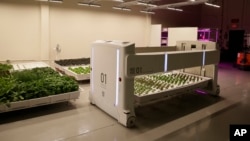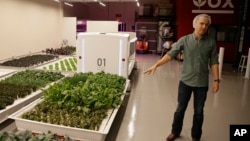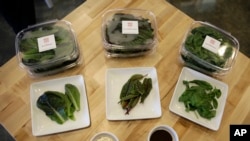Brandon Alexander is a former Google engineer who is trying to change American agriculture through robotics.
Alexander operates a machine-powered farm. He recently introduced his star robot – named Angus – to the Associated Press.
The long, white robot weighs more than 450 kilograms. Like other robots, it is equipped with cameras and mechanical arms to automatically perform many different jobs.
Angus is a major part of operations at Alexander’s indoor robot farm about 40 kilometers south of San Francisco. The 743-square meter farm uses a hydroponic system that grows plants without soil. The plants grow inside equipment that provides a continuous flow of water. The indoor farm uses electrical light instead of sunlight.
This kind of farm uses much less water and does not require human labor to run. The main job for Angus is to move thousands of plants around the farm, from small containers to larger ones as they grow. Angus also carries plants to another robot that does not have a name yet. Angus moves slowly to complete its work. But the robot is very strong and can lift about 300 kilograms.
For now, the farm uses humans to collect vegetables and other crops when they are ready. But Alexander says he is working on a robot that will eventually take over that job too.
Alexander helped start the company Iron Ox after leaving Google, where he worked on robotics at the company’s Google X project. He teamed up with another former Google employee, Jon Binney. Together they founded Iron Ox.
Before launching the company, the two men thought about how they could use their engineering knowledge and skills to do something more meaningful. “If we can feed people using robots, what could be more impactful than that?” Alexander said.
Iron Ox’s website says the hydroponic growing system uses 90 percent less water. It also said the growing method is up to 30 times more productive than growing crops on land.
Alexander said growing food robotically throughout the year in major cities will provide a more consistent and fresh product. Most of the vegetables sold in the U.S. are grown in California, Arizona, Mexico and other nations. That means that many people in U.S. cities are eating vegetables that are nearly a week old by the time they arrive in stores.
Iron Ox is currently negotiating with several San Francisco area restaurants that have expressed interest in buying vegetables, Alexander said. The company also expects to begin selling its products to local stores next year. “And they are going to make the best salads you ever tasted,” he said.
Indoor farms operate all year and are not generally affected by bad weather. Iron Ox said this will permit the company to provide a steady flow of goods without major price changes.
During the next few years, Iron Ox said it plans to open robot farms in other areas near U.S. cities. The plans call for the farms to be built inside greenhouses instead of large indoor spaces. These designs will use mostly natural sunlight to greatly cut electricity costs and save energy.
Some environmental experts say robotic farming is also likely to grow because of population. The number of people living on earth is expected to reach 10 billion by 2050. The world’s population is currently about 7.5 billion. A report by the World Resources Institute says such growth will make it important to find ways to feed more people without further harming the environment.
I’m Bryan Lynn.
Michael Liedtke reported on this story for the Associated Press. Bryan Lynn adapted it for Learning English. Mario Ritter was the editor.
We want to hear from you. Write to us in the Comments section, and visit our Facebook page.
_________________________________________________________________
Words in This Story
automatically – adv. independent; without human control
hydroponics – n. method of growing plants in water, rather than growing them in earth
found –v. to begin or create
impactful – adj. having a powerful effect on a situation or person
consistent – adj. always behaving or happening in a similar way
salad – n. cold mixture of uncooked vegetables usually prepared with a meal











